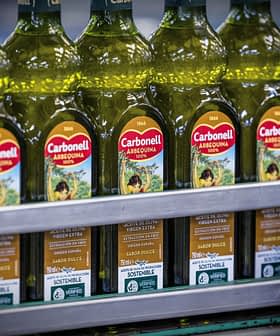Not just the vastness but also the profit margins make the United States arguably the most important olive-oil market in the world, Spanish-based olive oil giant Deoleo says in a new report.
The U.S. is the land of opportunities, but it is also a cruel market for those who are not prepared to fight.
Deoleo said olive oil markets are usually high profit, low consumption or high consumption, low profit but in the U.S., both the market and unit profit margins are big.
“In contrast with (U.S.) retail prices of over $8/liter, in Italy prices are around €4/liter and in Spain, €3/liter,” Deoleo said in its 2013/14 annual report. The main reason is North American retail margins are very high, while in Spain olive oil is often used as a loss leader “which is extremely destructive for the category.”
The U.S. market is thus crucial because the profit there, apart from providing an outlet for production, helps finance development, innovation, and marketing which have a flow-on effect throughout the value chain, it said.
Half the olive oil really Spanish
If focusing on the areas where olive oil consumption is concentrated the U.S. – the east coast, west coast, Texas and around Chicago – “the per capita consumption in value is close to that of the traditional oil-consuming countries.”
While on paper Spain provides under a quarter of the about 300,000 tons of olive oil the U.S. market imports annually, when taking into account the level of processing, packaging and re-exportation of Spanish olive oil by Italy, Spain supplies about half of all olive oil consumed in America, Deoleo said, “so any fall in consumption would have a big impact on its ability to market national production.”
Challenges and opportunities in the U.S. olive oil market
In its analysis of the “challenges, opportunities and future threats” of the U.S. olive oil market, Deoleo said these fall into two categories: factors related to the development and eventual maturity of the market; and those connected with a lobby group driving the agenda there.
It said growth is starting to slow and consumption to even fall in certain periods, namely when prices rise abruptly. It’s thus important to:
- understand how American consumers perceive the product, its use and culinary features compared to other types of oils and fats;
- heed what consumers want, without imposing “our tastes or traditions; be open to creating new categories or developments;”
- monitor channels and formats that destroy value, such as private label and club stores;
- accept that local producers will gain more shelf space and a larger share of consumer spending;
- expect a growing number of local bottlers in the U.S., meaning the applicable margin will be earned in the U.S. rather than traditional exporters;
- expect a ‘dilution’ of olive oil consumption, especially in the food service sector, given “the law does not impede, or at least not prosecute, blends of olive with other vegetable fats;”
- be aware of incorrect practices by certain operators outside the E.U., but also within it, which distort competition;
- study how other vegetable oils are championing health benefits which till now were key to growth in the olive oil category, especially recent moves in the canola (rapeseed) and corn oil sectors, “both with significant nutritional and health value, and which aim to compare themselves favorably against olive oil.”
Lobby group seen as threat
Though it didn’t name it, Deoleo took a swipe at what it described as “a local lobby sponsored mainly by Spanish investors, which developed an olive farm in north California with ROI expectations that are unlikely to be met, considering the excessive investment made.”
These investors are seeking higher prices for olive oil and accuse Spanish exporters of fraud, adulteration, dumping and government subsidies, while also pushing for a non-IOC (International Olive Council) trade standard, import barriers and the denigration of olive oils from traditional producers, it claimed.
The resulting consumer uncertainty and other effects have aided other vegetable oils, “which are enjoying growth that was previously characteristic of olive oil.”
Conclusions: room for growth in the North American market
The U.S. market is ready to buy more olive oil, it’s just a matter of knowing how to achieve this, such as finding new ways and times for consumers to use it, promoting it as a substitute for less healthy or tasty oils, improving distribution, and getting new consumers to not only try it but come back for more, Deoleo said.
“It’s a question of building markets, not just placing volume. The producers, the entire chain, must be responsible and work on improving the quality and competitiveness of our oils…but we must also point out the ‘black sheep’, the minority who give the entire sector a bad name.”
“The U.S. is the land of opportunities, but it is also a cruel market for those who are not prepared to fight,” it said.






